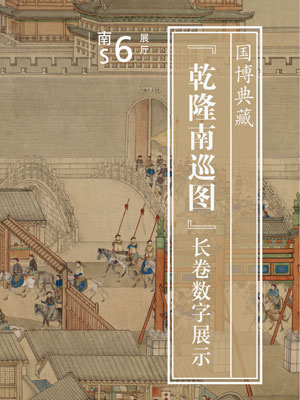 |
|
- Date : Theme Exhibition (Permanent)
- Venue : Gallery S6
- Hosted by: National Museum of China
Emperor Qianlong’s Southern Inspection Tour, one of China’s classical paintings housed in the National Museum of China, is composed of 12 scrolls, measuring 68.6cm in width and 15,417cm in overall length. The scrolls illustrate the scenes of Emperor Qianlong inspecting south China for the first time in the 16th year of his reign (1751).
In that year, to accompany the Empress Dowager in her 60s on her trip southward, Emperor Qianlong decided to model himself on his grandfather Emperor Kangxi, conducting an inspection to the south of China. Departing from Beijing, the Emperor headed south to Shaoxing and then returned to the capital. He traveled over 5,800 li in 112 days. On the trip, he wrote a total of over 520 poems. Following the practice of doing paintings based on the emperor-written poems, 12 pieces were selected out of these poems and royal court painter Xu Yang were commissioned to execute these paintings in the sequence in which these poems were created.
Painter Xu capitalized on the realistic skills to blend traditional Chinese poetry, calligraphy and painting together into these scrolls, depicting a series of scenes about Emperor Qianlong’s southern visit. These scenes were mainly about how he inspected local conditions and customs, visited officials and commoners, checked water systems and military preparations, offered sacrifices in temples, and went sightseeing at tourist attractions. This exhibition is held to present a large-sale dynamic digital display which has been elaborately produced based on the Scroll I of the painting “Departure from the Capital” by the National Museum of China. The digital display showcases a scene where the inspection team, departing from the Meridian Gate, marched westward along the Xiheyan Street, got out of the Guangning (Guang’an) Gate, then passed through the Gongji Town of Wanping County, Lugou Bridge, and Changxindian Town and finally came to a temporary imperial palace located in Huangxin Village, Liangxiang Town. In this scroll, one can see the grand imperial procession, resplendent imperial palace and gardens, magnificent city walls and arrow towers, bustling commercial streets, quiet and beautiful urban suburbs and countryside, all of which allow visitors to experience the spectacle of the golden age of the Qing dynasty, spanning the reigns of three Emperors Kangxi, Yongzheng and Qianlong. |